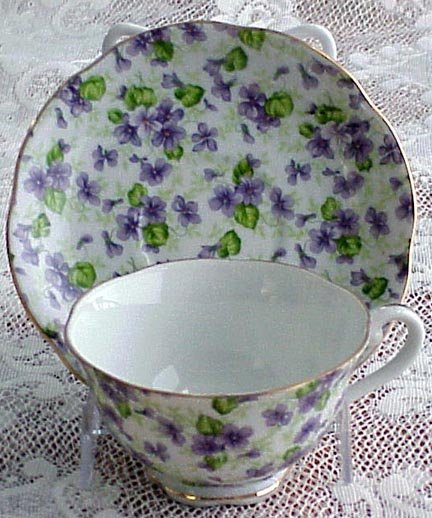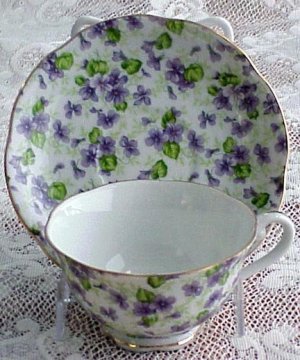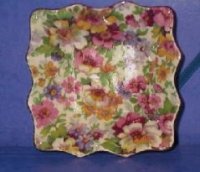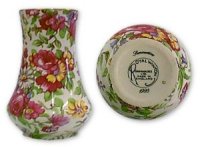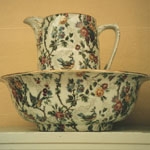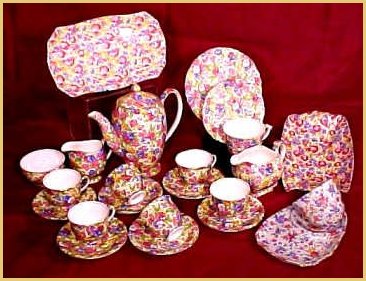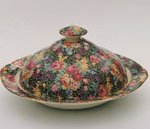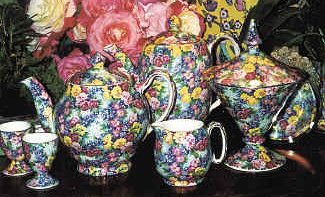|
collecting vintage commercially
made chintz
Collecting vintage chintz china has become a remarkable phenomenon! Chintz
china,twentieth century transfer ware, which evokes images of summer gardens
in full bloom and provides collectors with indoor flowers year round,
has exploded onto the collectibles scene.
Over the last few years, the price and popularity of this china have
experienced unprecedented growth. Collectors worldwide seek this charming
floral tableware which seems to attract more and more devotees with each
passing day.
The term "chintz" has its origins in India (the Indian word
was chintes) where colorful patterns including richly-hued flowers and
brightly plumed birds were printed on cotton fabric and imported into
England from the late seventeenth century.
When transfer printing was developed, it enabled chintz to be printed
cheaply enough to reach a large market, and by the mid-1800s a number
of the Staffordshire factories in England were producing chintz china
which was aimed toward everyday use and the mass market. The first chintz
china patterns were loose designs with larger flowers and birds; however,
around 1920, patterns for chintz china were designed with more tightly
placed, smaller flowers; and it was then that the collectible china which
is known generically today as "chintz" began to be made. Collectible
vintage chintz china was manufactured from the 1920s until the late 1960s.
Although many chintz manufacturers made goods which now are included
in the Chintzware category, four of the major and most sought-after producers
in England were Royal Winton, Lord Nelson Ware (Elijah Cotton Ltd.), James
Kent Ltd. and
Crown Ducal (A.G. Richardson). When chintz was made, it was not expensive
china. It was earthenware meant to be used every day. However, the production
of chintz did require an amazing amount of hand work because the designs
which appear on each piece of Chintzware were transferred by hand from
lithographs onto the individual pieces. The process (similar to applying
decals) required meticulous cutting and matching to ensure that the joins
on each piece (the places on the dish where the sheet of lithographic
paper came together), were practically invisible. This handwork, along
with any gilding on each piece, was done before the piece was fired.
Today, the knowledge that some young woman spent hours carefully placing
the beautiful transfer patterns on each piece of chintz makes the owner
of that piece much more appreciative of his treasure. The names given
to the chintz patterns are as appealing as the patterns themselves.
Royal Winton made more than fifty flowered patterns with names like
"Summertime," "Sweet Pea," "June Roses"
and "Old Cottage Chintz." Lord Nelson Ware made "Rosetime,"
"Heather" and "Briar Rose" to mention a few.
While Crown Ducal did not stamp its chinz with pattern names, the authors
of recent books have assigned names the the Crown Ducal patterns to provide
a uniform method of identification where reference to old sales catalogs
and other research have resulted in no actual company-assigned names.
Lord Nelson Ware produced patterns with names such as "Primula,"
"Apple Blossom" and "Hydrangia."
Besides the four most sought-after makers of English chintz mentioned
above, other chintz makers
included Barker Bros., Ltd., Brexton, Empire, S. Ford & Co., Johnson
Bros. Ltd., W.R. Midwinter, Ltd., Myott,
Ridgeway, Royal Doulton, Shelley, Wade, Wedgwood, A.J. Wilkinson and Wood
& Sons. Some Dutch Chintzware has also been found. Chintzware also
was made in Japan, Germany and Czechoslovakia, although these patterns
are considered by many to be less collectible than the English chintz.
Chintz comes in all shapes and sizes, from complete dinner sets to tiny
nut dishes. Some collectors attempt to collect a set of chintz all in
one pattern and to find as many serving pieces, teapots, coffeepots and
other matching pieces as possible.
Because chintz has such a cozy and colorful feel, other collectors enjoy
mixing the many patterns and makers and displaying them in pretty groupings
around their homes.
Others focus on collecting teacups in the many different patterns or
try to locate bud vases in as many patterns as possible. Whatever their
choices about the focus of their chintz collections, most chintz collectors
agree that there is something so
warm and inviting about chintz that just seeing it each day makes them
happy.
|
